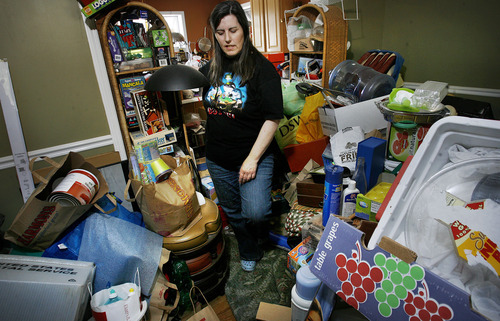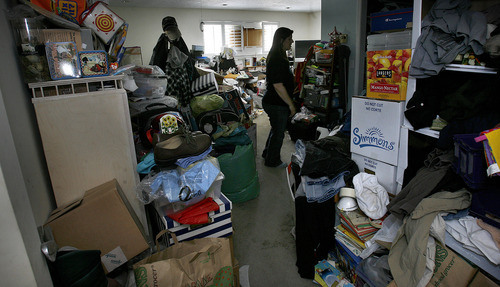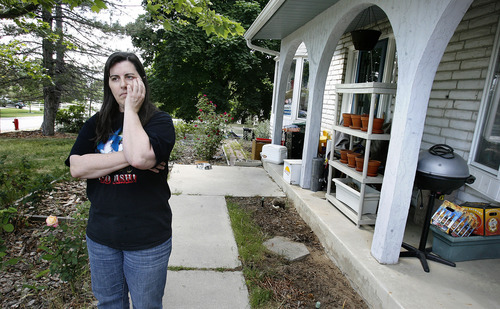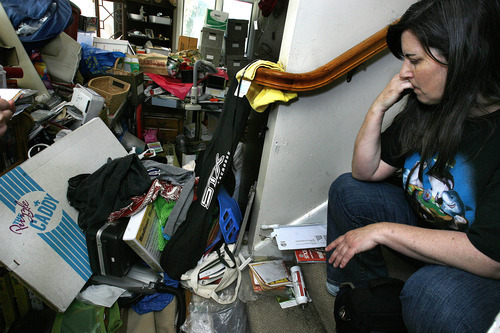This is an archived article that was published on sltrib.com in 2012, and information in the article may be outdated. It is provided only for personal research purposes and may not be reprinted.
To understand the avalanches pressing against every wall of K Kay's house in Sandy, it helps to inventory the first pile behind her front door.
It is about 3 feet tall — relatively small. There is a lacrosse bag full of yardsticks, several small decorative pillows, a trumpet, a jigsaw puzzle caddy, books, blankets, a vacuum cleaner and a toilet seat designed for a cat.
At the pile's foundation: an unassembled, unwrapped set of brand new stacking shelves Kay bought "about 10 years ago but never figured out where they should go," and the home's welcome mat — once meticulously washed and ready for use but left in a crumpled heap because, Kay says, "I didn't get the floor washed just right to put it back down."
Hoarding has left Kay trapped between what she describes as obsessive perfectionism and an addiction to stuff. But unlike the stereotypical old lady with a million cats, Kay is 49, with a young family, a career as a piano teacher and many years ahead of her. Now she is trying to advocate for fellow hoarders by talking with city officials, starting an online support group, and doing something physically and emotionally impossible for many people like her: opening the front door.
—
Accumulation • The pile next to the door is only a few months old — the latest foothill in a mountain range that has developed over the 10 years since Kay and her family moved to the house.
Back then, Kay's problems already were evident. A bad day would inevitably end in a thrift store, where she would imagine the perfect home and use for every item. Buying these things was like finding and rescuing treasure, and that made Kay happy.
But the treasure needed to be dealt with. Every new item had to be cleaned, packaged and stored in "the perfect way," Kay says. Each of those steps came with its own set of decisions and plans, all of them complicated by the growing clutter on table space and counter tops. A single toy for her niece would turn into multiple daunting projects.
"Then it's the 'drop-stuff' reaction: I can't deal with this right now. I can't decide the perfect thing to do with it or I'm too tired to find the perfect thing to do with it," Kay says.
So the thrift-store purchases went into piles. In later attempts to organize, Kay divided the piles into mini-piles. The toy was put next to the bedroom door in a stack with other gifts intended for her nieces.
The stack is now as tall as Kay.
There are dozens of piles just like it in almost every room. Many contain craft supplies to make educational games for children — Kay's passion since anxiety forced her to give up her career as a classroom teacher. Many contain unsent gifts for friends and family. Many, ironically but not surprisingly, contain sundry organizational tools such as drawer separators and filing boxes.
To Kay, each pile represents a failure: a failure as a parent, a failure as a teacher, a failure to take care of belongings that are so valuable to her that throwing anything away makes her physically ill. Each pile fills Kay with sadness and dread, and for that she turns to her only salve: more stuff.
—
Consequences • For the most part, Kay is able to speak with some detachment as she explains the process and feelings of hoarding. Vocabulary like "frontal lobe" and "basal ganglia" slide into conversation, and she talks about her behavior not just as hers but as that of a larger population of hoarders. "We are perfectionists." "We buy multiples of everything." "We procrastinate and fear treatment because what if it doesn't work?"
But one topic shatters any sense of abstraction: Kay's family.
Her husband and 15-year-old daughter each have their own rooms that are off-limits to Kay's belongings. But the effect of hoarding on them and on Kay's two adult daughters has been extreme.
"I didn't let myself believe it when my older two were growing up," Kay said. "I couldn't admit it to myself. You just can't exist if you fully accept what harm you're causing to other people."
The girls' social lives suffered because "the kids can't bring anybody home," Kay explains. "There's no place to sit." Her husband had a heart attack nine years ago that coincided with a stressful time at his job as a computer programmer — "but to say my illness didn't massively contribute to that stress would be naive," Kay said.
The person most direly affected by Kay's hoarding is her 15-year-old daughter. The girl has lived in the house through the very worst of times. Health problems have kept her out of school and studying at home with a tutor for three years, Kay says.
Social workers inspected the home, Kay says. While they found conditions amounted to "environmental neglect," they couldn't identify a specific hazard that would justify the girl's removal. Kay says she has searched for mold and other contaminants. Had a culprit been evident, "I would have sent her to her sister's," Kay insists.
The teen appears to be recovering after a month on a new diet, Kay says. The family hopes she can return to school in the fall. But that doesn't shift the weight of environmental neglect.
"When you can't function, you can't do what mothers do. You can't keep a decent living space," Kay says.
And nothing can repair the years that already passed.
"You tell yourself it's not that bad. You'll get it cleaned up, and they won't remember the bad years. By next year, by this holiday or that holiday. …" Kay begins to cry. "By their next birthday. By next year, it will all be good."
—
Accountability • Now Kay is facing a code violation. Neighbors last year complained of clutter on her porch, and Sandy deployed its Community Action Team for public nuisances, which brings together representatives from various city departments. Kay explained her history: years of deterioration with occasional therapy that was too expensive to sustain. In September, she gave a presentation on hoarding to the action team.
"There's not a lot of information out there to begin with. Information from a hoarder's perspective? There's very little," said Marsha Millet, a mayoral adviser who leads the action team. "It was very illuminating to hear from someone who actually has a hoarding problem and admits to having it."
But the porch clutter remained. The city offered to send volunteers to help clean up the mess, a tactic that resolved a previous hoarding case, Millet said. Kay declined.
"That would make the problem go away for the moment," Kay says. "I know it will come back, and you don't dishonor people's work like that. And there are elderly hoarders that need that help more than me."
Kay was charged with a misdemeanor. She said a prosecutor offered her a plea in abeyance last month on the condition she simply clean up the yard. Again, Kay declined.
"I'm tired of making promises for a function I don't have," Kay says. "It's not that I don't think my neighbors have a right to protect their property values. I understand what the law is there for."
She says she also understands the city has no choice but to enforce it, as there are no resources to provide hoarders with the one lasting solution: treatment. Defending against the charge by claiming mental illness may not be legally tenable, but Kay hopes " it will force a conversation higher up that will give [the action team] the tools they need to deal with this."
—
Solutions • Hoarding is generally considered an expression of obsessive-compulsive disorder in which patients "overvalue things," says Jim Lewis, one of just a handful of therapists in Utah who specialize in hoarding. "As a consequence, they don't think they can dispose of it or give it to anyone else because then they're not being loyal to the meaning that the object has to them."
The compulsion is so strong that recognizing the problem is not enough to solve it, says Lewis, who practices in Sandy.
"It's incomprehensible to most people how I can sit and talk about it and then not figure out how not to do it, how not to go to the thrift store," Kays says.
The therapy hoarders need can be intensive and long-term, Lewis says.
"Without professional help, it's very unlikely they will succeed," he says. "These problems are so intense, so deep, so embedded. Nothing is working, and they just feel trapped and hopeless and start living in their obsessiveness."
Cognitive behavioral therapy is used to break down the belief in the hoarded items' value, Lewis says. Home visits and regular sessions — at least weekly, and sometimes more — are set up to encourage new habits and tackle the mess, starting with a single corner.
"There are people that overcome this," he says. But cost can be a holdup. Many insurers don't cover treatment for OCD, he says. Kay's covered 50 percent — "which may as well be zero ... when it's $75 to $150 per hour," she says.
Affordable care is the major missing piece in the hoarding response protocols Sandy began revising after Kay's presentation last year, Millet says.
"There just weren't a lot of people we could refer anyone to," she says. "The [hoarder] has to have money … or they're just out of luck."
Sandy's goal, Millet says, is to go beyond punishment in cases of "clean hoarders" — ones whose hoards don't involve animals, food waste or other potential health hazards. She says the most successful approach has been to ask neighbors and friends to join city worker in a clean-up led by the hoarder, which is critical because giving up items can be traumatic, especially if they aren't handled with care.
"It's hard to help [Kay] because there's a certain way she wants it done. If I just do it for her, it would totally stress her out," confirms Kay's longtime friend, Julie Strong. For example, Kay cannot bear to just drop old clothes off at the thrift store; they first have to be washed, pressed and placed on hangers.
Other cities have developed their own strategies. In Orem, officers refer hoarders to Wasatch Mental Health, said neighborhood preservation officer Kirk Bertelsen. West Valley City has an annual budget to hire cleaning crews to perform court-ordered clean-ups in cases where notices and fines do not prompt improvement, said Layne Morris, director of West Valley's community preservation department.
But code-enforcement workers agree: a continuing support system is key, and not much is available.
That is one deficit Kay hopes to fill. Last week she launched a "Hope for Hoarders" group on Meetup.com. She is setting up separate groups for friends and family of hoarders.
"It's so hard for people to believe that we can't just change," she says. "Right now, all I'm hoping for is respectful curiosity."
Twitter: @erinalberty



















